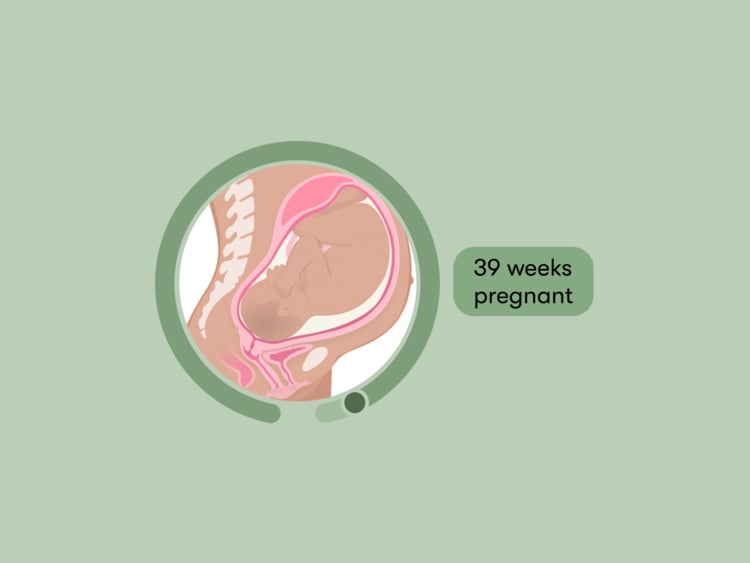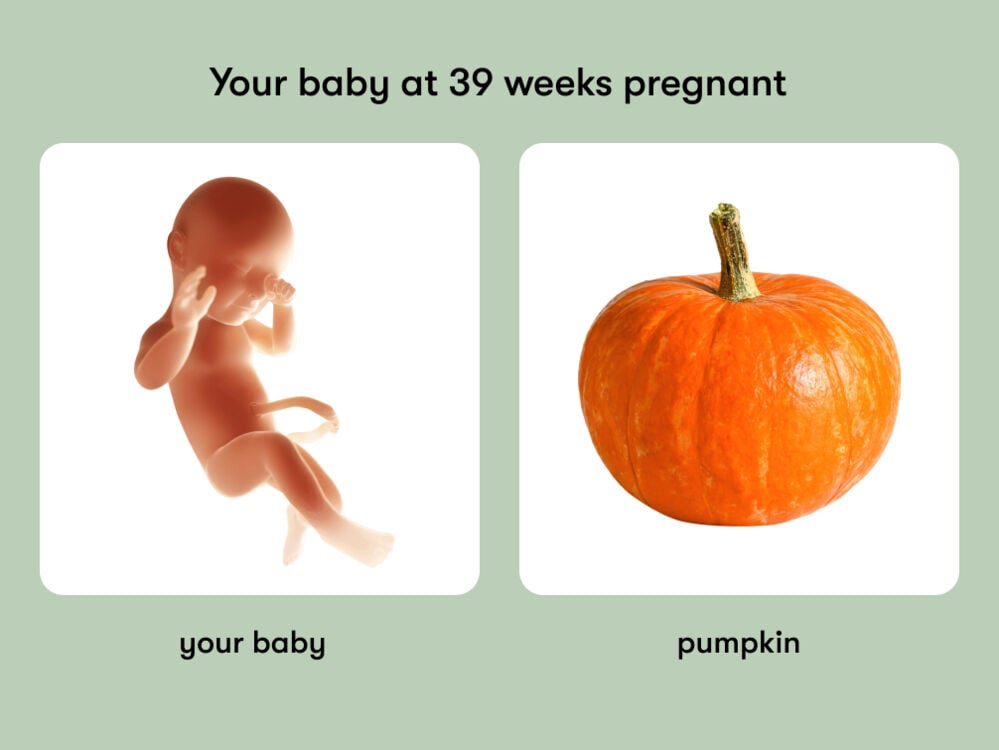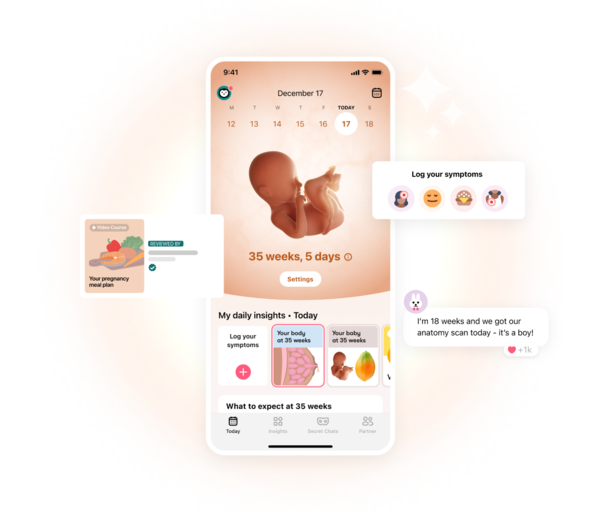From preparing for childbirth to your baby’s skin changing, here’s the lowdown on being 39 weeks pregnant.
-
Tracking cycle
-
Getting pregnant
-
Pregnancy
-
Help Center
-
Flo for Partners
-
Anonymous Mode
-
Flo app reviews
-
Flo Premium New
-
Secret Chats New
-
Symptom Checker New
-
Your cycle
-
Health 360°
-
Getting pregnant
-
Pregnancy
-
Being a mom
-
LGBTQ+
-
Quizzes
-
Ovulation calculator
-
hCG calculator
-
Pregnancy test calculator
-
Menstrual cycle calculator
-
Period calculator
-
Implantation calculator
-
Pregnancy weeks to months calculator
-
Pregnancy due date calculator
-
IVF and FET due date calculator
-
Due date calculator by ultrasound
-
Medical Affairs
-
Science & Research
-
Pass It On Project New
-
Privacy Portal
-
Press Center
-
Flo Accuracy
-
Careers
-
Contact Us
39 weeks pregnant: Your guide to this week of your third trimester


Every piece of content at Flo Health adheres to the highest editorial standards for language, style, and medical accuracy. To learn what we do to deliver the best health and lifestyle insights to you, check out our content review principles.
At 39 weeks pregnant, you’re nearly ready to meet your baby. Have you thought about names yet? At this point in your pregnancy, you’re officially considered to be full term. This means your baby can come at any time, and your due date is fast approaching.
In weeks gone by, you may have focused on getting all of the vitamins, nutrients, and minerals you need for your baby’s development. You may have watched your bump grow and change shape. However, at this point in your pregnancy, it might just feel like a waiting game for your baby’s arrival. While some people find it comforting to read up on labor and delivery and check off the items in their hospital bag, others take the last days of pregnancy to kick back and relax. So here’s a guide to what’s happening with your body and baby at 39 weeks pregnant, including a few tips to be as comfortable as possible.
Your baby at 39 weeks pregnant
Your baby is almost ready to be born
“At 39 weeks, the baby is full term and is continuing to grow,” explains Dr. Allison K. Rodgers, reproductive endocrinologist, obstetrician, and gynecologist at Fertility Centers of Illinois, US. “They typically grow about half a pound per week, and many babies will be head down, which causes a lot of pelvic pressure. Walking can be difficult with the pressure coming from within. Babies are practicing breathing to strengthen those muscles, but there isn’t much room to move around like they did when they were smaller.”
As you prepare your baby’s nursery and pack your hospital bag, they’re continuing to gain weight to prepare for life in the outside world.
Your baby’s skin is no longer translucent
Only a few weeks ago, your baby’s skin was transparent and wrinkly. However, during the second trimester, as they gain weight, they lose some of those wrinkles, and they produce melanin which gives their skin and eyes color. Their skin is no longer translucent, and the soft, downy coating of hair (lanugo) that covered your baby is starting to fall away, too. They may be covered in the creamy protective coating called the vernix caseosa, though this may have gone when your baby arrives.
How big is a baby at 39 weeks?
Length (crown to heel): 50 cm or 19.7 in
Weight: 3.4 kg or 7.6 lb
Size: Equivalent to a pumpkin
All measurements are approximate and vary within the normal range.

Your body at 39 weeks pregnant
Your water breaking
As you approach your due date, preparation for labor has likely been on your mind. This can mean picking out a name and your baby’s first outfit, but it can also be helpful to learn some of the signs of labor. One crucial sign that active labor is approaching is your water breaking.
You’ll likely have heard stories about water breaking and may have seen it depicted in movies and on TV. It’s when the amniotic sac, which your baby grew inside of, breaks. The clear or pale yellow fluid (amniotic fluid) then drains from your vagina. You may feel a popping sensation when this happens, and the liquid may appear as a trickle or more of a gush. If you think your water has broken or you experience a loss of liquid from your vagina, reach out to your health care provider.
You might start to experience contractions
Another indicator that you’ve gone into labor is if you start to experience contractions. Contractions are the periodic tightening and relaxing of your uterine muscles. It may feel like your bump is going hard and then relaxing. They get progressively closer together and may last for around 60 to 90 seconds. Once your contractions are lasting for this length of time and are five minutes apart, you should call your hospital or health care provider.
Your questions answered
What are the chances of giving birth at 39 weeks?
As 39 weeks is considered to be full term, you could go into labor at any time. However, it can be difficult to know exactly when you’ll deliver your baby. While some people have their baby before their due date, others carry into weeks 41 and 42. Statistics collected on births in 2017 found that 57.49% of recorded births in the United States happened between 39 and 41 weeks. Twenty-six percent occurred between 37 and 38 weeks, 6.5% happened during week 41, and 0.33% during week 42.
If you’re curious if your baby is in the head-down position and engaged for birth, you can speak to your doctor.
How do you tell labor is a few days away?
As mentioned above, it’s hard to tell if labor is a few days away, but the best thing to do is to look for some of the signs of labor. They include:
- Your water breaking
- Feeling your baby has dropped lower
- Increased vaginal discharge
- Your cervix starts to dilate (Your doctor will have to check this.)
Some people will start to experience labor pains hours and even days before they enter active labor, so the signs of early labor don’t necessarily mean your baby will be with you promptly. However, if you notice some of the signs of labor, then it’s important to call your health care provider so they can advise you on what to do next.
What should I be feeling at 39 weeks pregnant?
At this late stage of pregnancy, you might be feeling excited, daunted, or just a bit uncomfortable. This is completely normal. “The further you get, the more uncomfortable you may become,” says Dr. Rodgers. “After all, you are carrying around a growing baby!”
Take a quiz
Find out what you can do with our Health Assistant
39 weeks pregnant checklist
Get ready for your baby’s arrival
Reaching 39 weeks pregnant and full term might feel like a milestone moment, the time in your pregnancy you’ve been looking forward to. However, waiting for labor to begin and for your baby to arrive can be frustrating.
Try to prioritize being comfortable by continuing to drink enough water (it may help ease some constipation and tiredness) and get as much rest as you need. You may find it helpful to write down how you’re feeling in a journal. This can be handy to process any feelings you have about birth — both the excited and more anxious. You may even like looking back at it once your baby is here. Similarly, don’t repress any worries or anxieties. Speak to your birth partner, family, friends, and doctor.
If you’ve been attending prenatal classes, then keep going, and have a labor bag packed with all of your essentials. This can include lots of extra clothes for you and your baby, toiletries, and any medicines you’re taking. If you have one, it’s also a good idea to pack your birth plan.
Monitor your baby’s movements
Throughout your third trimester, you may have gotten into the habit of monitoring your baby’s unique rhythm of movement and activity. You can do that by kick counting — lying on your side with your hands on your bump. You can then count how many times your baby moves in one hour. In general, around 10 movements in one to two hours is considered typical fetal movement, but get to know your baby’s unique pattern so you can monitor this throughout the remainder of your pregnancy.
By 39 weeks, you’ll likely be pretty acquainted with your baby’s movements, and despite the fact that your baby is taking up most of the space inside your uterus, you should continue to feel their movements as much as before. Before, your baby had enough space to do full somersaults and pronounced kicks, but now, they’ll feel more like a roll or a poke. Remember to keep taking note of how often you feel your baby move and keep counting their kicks so you can tell your health care provider if they’re moving less than usual.
When to consult a doctor at 39 weeks pregnant
You’ll likely feel like a regular with your health care provider by 39 weeks pregnant. Depending on where you live, you may see them as often as once a week. Since you could have your baby at any time, it’s crucial to know and watch out for signs that you’re going into labor (listed above).
However, you don’t need to wait until your appointment if you have any concerns or questions about your pregnancy. At 39 weeks pregnant, you should contact your doctor immediately if you experience:
- Severe cramping
- Vaginal bleeding
- Changes in vaginal discharge
- Fever
- Dizziness or fainting
- Severe vomiting
- Severe headaches or blurry vision
- Intense heartburn
- A decrease in the amount you feel your baby move
This isn’t an exhaustive list but just some examples of the changes you should look for. Some of these can be a sign of health complications, so it’s essential that you speak to your doctor about the best next step for you. And if you’re worried about any other symptoms you experience during pregnancy, then don’t hesitate to reach out to your health care provider.
39 weeks pregnant: The takeaway
Between settling on a few baby names, packing your delivery bag, and getting familiar with the typical signs of labor, 39 weeks pregnant can feel a little bit like sitting in a waiting room — you’re full of anticipation and waiting for the main event. Try to be gentle with yourself this week, resting when you need it and vocalizing any concerns or questions you have to your loved ones or your doctor. It won’t be long before you meet your baby.


Hey, I'm Anique
I started using Flo app to track my period and ovulation because we wanted to have a baby.


The Flo app helped me learn about my body and spot ovulation signs during our conception journey.


I vividly
remember the day
that we switched
Flo into
Pregnancy Mode — it was
such a special
moment.
Real stories, real results
Learn how the Flo app became an amazing cheerleader for us on our conception journey.
References
“Week 37.” NHS, www.nhs.uk/start-for-life/pregnancy/week-by-week-guide-to-pregnancy/3rd-trimester/week-37/. Accessed 25 July 2023.
“Week 39.” NHS, www.nhs.uk/start-for-life/pregnancy/week-by-week-guide-to-pregnancy/3rd-trimester/week-39/. Accessed 25 July 2023.
“Urgent Maternal Warning Signs.” Centers for Disease Control and Prevention, www.cdc.gov/hearher/maternal-warning-signs/index.html. Accessed 25 July 2023.
“Nutrition during Pregnancy.” The American College of Obstetricians and Gynecologists, June 2023, www.acog.org/womens-health/faqs/nutrition-during-pregnancy.
“Fetal Development.” Mount Sinai, www.mountsinai.org/health-library/special-topic/fetal-development. Accessed 25 July 2023.
“Fetal Development.” Cleveland Clinic, my.clevelandclinic.org/health/articles/7247-fetal-development-stages-of-growth. Accessed 25 July 2023.
“Fetal Development: The 3rd Trimester.” Mayo Clinic, 3 June 2022, www.mayoclinic.org/healthy-lifestyle/pregnancy-week-by-week/in-depth/fetal-development/art-20045997.
“Fetal Positions for Birth.” Cleveland Clinic, my.clevelandclinic.org/health/articles/9677-fetal-positions-for-birth. Accessed 25 July 2023.
Friel, Lara A. “Fevers during Pregnancy.” MSD Manual Consumer Version, Sep. 2022, www.msdmanuals.com/home/women-s-health-issues/pregnancy-complicated-by-disease/fevers-during-pregnancy.
Hellegers, Andre E. “Fetal Development.” Theological Studies, vol. 31, no. 1, Feb. 1970, pp. 3–9, https://doi.org/10.1177/004056397003100101.
“How Much Water Should I Drink during Pregnancy?” The American College of Obstetricians and Gynecologists, Oct. 2020, www.acog.org/womens-health/experts-and-stories/ask-acog/how-much-water-should-i-drink-during-pregnancy.
“How Much Water Should I Drink in Pregnancy?” Tommy’s, www.tommys.org/pregnancy-information/im-pregnant/nutrition-in-pregnancy/how-much-water-should-i-drink-pregnancy. Accessed 25 July 2023.
“How to Tell When Labor Begins.” The American College of Obstetricians and Gynecologists, May 2020, www.acog.org/womens-health/faqs/how-to-tell-when-labor-begins.
“Pregnant? Here’s How Often You’ll Likely See Your Doctor.” Cleveland Clinic, 14 Jan. 2022, health.clevelandclinic.org/prenatal-appointment-schedule/.
“Kick Counts.” Cleveland Clinic, my.clevelandclinic.org/health/articles/23497-kick-counts. Accessed 25 July 2023.
Martin, Joyce A., et al. “Births: Final Data for 2017.” National Vital Statistics Reports: From the Centers for Disease Control and Prevention, National Center for Health Statistics, National Vital Statistics System, vol. 67, no. 8, Nov. 2018, pp. 1–50, www.cdc.gov/nchs/data/nvsr/nvsr67/nvsr67_08-508.pdf.
“Morning Sickness: Nausea and Vomiting of Pregnancy.” The American College of Obstetricians and Gynecologists, May 2020, www.acog.org/womens-health/faqs/morning-sickness-nausea-and-vomiting-of-pregnancy.
Nicholson, James M., et al. “New Definition of Term Pregnancy.” JAMA, vol. 310, no. 18, 13 Nov. 2013, pp. 1985–86, doi:10.1001/jama.2013.277993.
“Heartburn during Pregnancy.” Cleveland Clinic, my.clevelandclinic.org/health/diseases/12011-heartburn-during-pregnancy. Accessed 25 July 2023.
“Signs of Labor: Know What to Expect.” Mayo Clinic, 16 Dec. 2021, www.mayoclinic.org/healthy-lifestyle/labor-and-delivery/in-depth/signs-of-labor/art-20046184.
Singh, Gurcharan, and G. Archana. “Unraveling the Mystery of Vernix Caseosa.” Indian Journal of Dermatology, vol. 53, no. 2, 2008, pp. 54–60, doi:10.4103/0019-5154.41645.
“Water Breaking: Understand This Sign of Labor.” Mayo Clinic, 17 Nov. 2021, www.mayoclinic.org/healthy-lifestyle/labor-and-delivery/in-depth/water-breaking/art-20044142.
“The Stages of Labour and Birth.” NHS, www.nhs.uk/pregnancy/labour-and-birth/what-happens/the-stages-of-labour-and-birth/. Accessed 25 July 2023.
“Vaginal Discharge in Pregnancy.” NHS, www.nhs.uk/pregnancy/related-conditions/common-symptoms/vaginal-discharge/. Accessed 25 July 2023.
“What to Expect When Your Waters Break.” Tommy’s, www.tommys.org/pregnancy-information/giving-birth/what-expect-when-your-waters-break. Accessed 25 July 2023.
“Bleeding during Pregnancy.” The American College of Obstetricians and Gynecologists, May 2021, www.acog.org/womens-health/faqs/bleeding-during-pregnancy.
History of updates
Current version (25 September 2023)
Published (24 February 2019)
In this article

Get your personal guide to pregnancy with the Flo app
-
Follow your baby's growth week by week
-
Get expert info on symptoms, safe foods, and more
-
Chat with other parents-to-be




